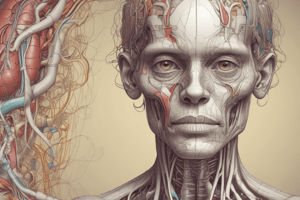Podcast
Questions and Answers
Epithelial is a type of muscle tissue.
Epithelial is a type of muscle tissue.
False (B)
Organs are groups of two or more tissues organized to serve a particular function.
Organs are groups of two or more tissues organized to serve a particular function.
True (A)
The cortex is the central portion of some organs.
The cortex is the central portion of some organs.
False (B)
The lumen is the outer layer of a hollow organ.
The lumen is the outer layer of a hollow organ.
A membrane is a layer of epithelium and its underlying connective tissue that covers a surface of the body.
A membrane is a layer of epithelium and its underlying connective tissue that covers a surface of the body.
The stroma is the functional part of an organ.
The stroma is the functional part of an organ.
Nerve tissue is a type of connective tissue.
Nerve tissue is a type of connective tissue.
Tissues are groups of cells organized to serve a specific function.
Tissues are groups of cells organized to serve a specific function.
Muscle is a type of connective tissue.
Muscle is a type of connective tissue.
The parenchyma is the supporting framework of an organ.
The parenchyma is the supporting framework of an organ.
Organs are formed by groups of three or more tissues.
Organs are formed by groups of three or more tissues.
The medulla is the outer region of some organs.
The medulla is the outer region of some organs.
A membrane always lines the surface of an organ.
A membrane always lines the surface of an organ.
Groups of organs do not form organ systems.
Groups of organs do not form organ systems.
The lumen is the outer layer of a hollow organ.
The lumen is the outer layer of a hollow organ.
Nerve tissue is a type of epithelial tissue.
Nerve tissue is a type of epithelial tissue.
Flashcards are hidden until you start studying
Study Notes
Course Objectives
- By the end of this course, students should be able to describe the normal microstructure and function of cell types, tissues, and organs of the major organ systems.
- Students should be able to assess the functional and clinical correlations of major disorders related to the organ systems.
General Organ Concepts and Terminology
- Tissues are groups of cells organized for specific functions.
- There are four main types of tissues: • Epithelial • Connective • Muscle • Nerve
Tissues and Organs
- Organs are groups of two or more tissues into an organized structure to serve a particular function(s).
- Groups of organs form organ systems to serve a specific function(s).
Terminology
- Lumen refers to the cavity or channel within a hollow organ.
- A membrane is a layer of epithelium and its underlying connective tissue that covers a surface of the body.
- Membranes line almost all surfaces of the body.
- Cortex refers to the outer region or portion of some organs, such as the kidney, lymph nodes, and adrenal glands.
- Medulla refers to the central portion of some organs, surrounded by a cortex.
- Stroma is the supporting framework of an organ, usually composed of connective tissue.
- Parenchyma refers to the cells and tissues of an organ that perform the function of the organ, composed of epithelial, muscle, nerve, and sometimes connective tissues.
Course Objectives
- By the end of this course, students should be able to describe the normal microstructure and function of cell types, tissues, and organs of the major organ systems.
- Students should be able to assess the functional and clinical correlations of major disorders related to the organ systems.
General Organ Concepts and Terminology
- Tissues are groups of cells organized for specific functions.
- There are four main types of tissues: • Epithelial • Connective • Muscle • Nerve
Tissues and Organs
- Organs are groups of two or more tissues into an organized structure to serve a particular function(s).
- Groups of organs form organ systems to serve a specific function(s).
Terminology
- Lumen refers to the cavity or channel within a hollow organ.
- A membrane is a layer of epithelium and its underlying connective tissue that covers a surface of the body.
- Membranes line almost all surfaces of the body.
- Cortex refers to the outer region or portion of some organs, such as the kidney, lymph nodes, and adrenal glands.
- Medulla refers to the central portion of some organs, surrounded by a cortex.
- Stroma is the supporting framework of an organ, usually composed of connective tissue.
- Parenchyma refers to the cells and tissues of an organ that perform the function of the organ, composed of epithelial, muscle, nerve, and sometimes connective tissues.
Studying That Suits You
Use AI to generate personalized quizzes and flashcards to suit your learning preferences.




